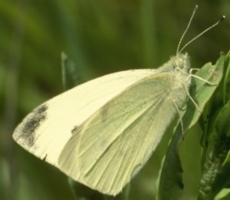|
|
ARTHROPODS:
Insects»
Spiders»
Centipedes»
Millipedes»
Sowbugs»
Harvestmen»
Mites
& Ticks»
Scorpions»
Identification
Tips»
About
the Critter Files»
Links» |
|
|
|
| Sulphurs
and Whites, together known as "pierids" (from
the family name, Pieridae), are usually easy to recognize by their
colors. Most species in this family have wings that are bright
orange, yellow, or white, often with a black markings. Female
pierids often have different colors and patterns than the males.
These butterflies do not have greatly reduced front legs,
as do the butterflies in the Nymphalidae. Most pierids are
small- or medium-sized butterflies. All butterflies have 4
scaly wings and coiled, siphoning mouthparts.
Because most sulphurs
and whites look very similar, it can be hard to identify individual
species without looking carefully at the wing patterns. Detailed
pictures of sulphurs and whites are available in the following field
guides:
Butterflies and Moths by
Mitchell and Zim
Peterson Field Guide to Eastern Butterflies by Opel and
Peterson
|
| |
| Most
Sulpher and White Caterpillars are small and green
with yellow or white stripes. Like all moth and butterfly larvae,
pierid caterpillars have chewing mouthparts. |
| |
 Imported Cabbageworm:
a pierid caterpillar
Imported Cabbageworm:
a pierid caterpillar
(R. Bessin, 2002) |
|
| SIZE:
Adult wingspan up to 2 3/4", caterpillar up to 1" |
| |
| LIFE
CYCLE |
|
As
with all butterflies, sulphurs and whites have complete metamorphosis
with egg, larval, pupal, and adult stages. Adults are active
throughout the warm months. Some pierid species are among
the first butterflies seen in early spring. Most species have
several broods each year.
|
| ECOLOGY |
|
Sulphurs and whites
and thier caterpillars are very common in fields, meadows, and other
weedy areas. The caterpillars feed on a variety of plants,
depending on species. Some common host plants include clover,
alfalfa, and various mustards and legumes. The adult butterflies
feed only on nectar.
Thier green coloration
helps pierid caterpillars avoid predation, but they are nevertheless
preyed upon by a variety of creatures, including birds, spiders,
and insects. Pierid adults are preyed upon by birds, crab
spiders, and flying insect predators.
|
| |
| PEST
STATUS |
|
This family
contains some of the only butterfly pests in our part of the country.
The Imported Cabbageworm (shown above)
feeds on cabbage and a few related plants. The adult form,
often called the Cabbage Butterfly, Pieris rapae, is shown
below. |
| |
| COMMON
KENTUCKY SULPHURS & WHITES |
|
|
CABBAGE
BUTTERFLY
GENUS and SPECIES:
Pieris rapae
Cabbage Butterfly,
Pieris rapae, is a white butterfly with black-tipped wings.
Its larva, the Imported Cabbageworm, is a pest of vegetable
crops. Read more about it in our Cabbage
Insects factsheet.
|
| |
 Cabbage Butterfly: the adult form of the Imported
Cabbage Butterfly: the adult form of the Imported
Cabbageworm (Corel Photo CD, 1993) |
|
|
|
SULPHUR
GENUS:
Colias and others
Butterflies in the family Pieridae that are mostly yellow in color are often called Sulphurs. There are many species refered to as Sulphurs; pictured below is a typical example. |
| |
 Sulphur
(R. Bessin, 2002)
Sulphur
(R. Bessin, 2002) |
|
|
|
CHECKERED
WHITE
GENUS and SPECIES:
Pontia protodice |
| |
 Checkered White (R. Bessin, 2000)
Checkered White (R. Bessin, 2000) |
|
| |
| COLLECTING
& PHOTOGRAPHY |
|
Adult sulphurs and
whites can be found throughout the spring and summer in open fields,
meadows, and near the forest edge. Some of the small species
are fast fliers, and can be difficult to catch. Use a butterfly
net to keep from damaging the wings.
Once captured, it is
best to keep any butterfly in a "butterfly envelope".
Visit this page to learn how to make your own butterfly envelopes:
http://www.kellscraft.com/butterfly01.html#COLLECTIONS
Butterflies make great
photography subjects, but getting a good picture can be a challenge
- even when the butterflies aren't flying, they are almost always
walking around or moving their wings up and down. One technique:
find a sulphur or white early on a summer morning. It will
still be warming itself and will be less likely to fly away.
Pierid caterpillars can
be found feeding on various mustards and legumes. All insect
larvae should be preserved in alcohol. If you try raising
a peirid caterpillar, remember that it is very picky, and it will
probably only eat leaves from the type of plant on which it is found
when caught.
|
| |
| MYTHS
- LEGENDS - FOLKLORE |
|
Have you heard any
myths, legends, or folklore about pierids or other butterflies?
If so, let us know. |
Original document: 25 May 2004
Last updated: 25 May 2004
Monarch and Viceroy
Butterfly photos courtesy Corel, 1993. Used with permission. Other
pPhotos courtesy R. Bessin and B. Newton, University of Kentucky
The Kentucky Critter Files are maintained by Blake Newton, Department
of Entomology, University of Kentucky.
Contact: blaken@uky.edu
|
|

